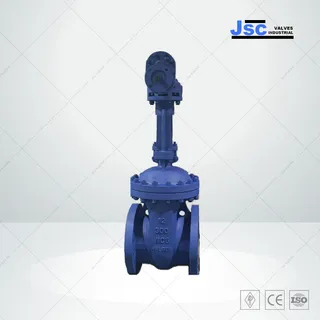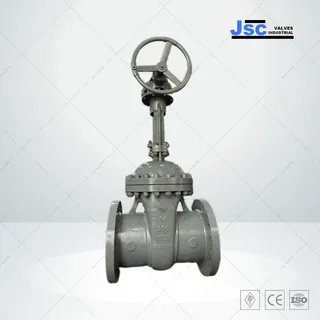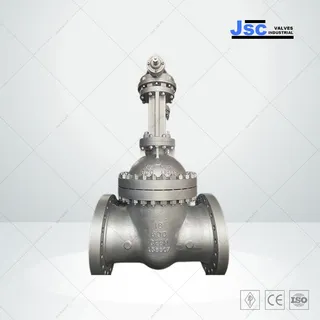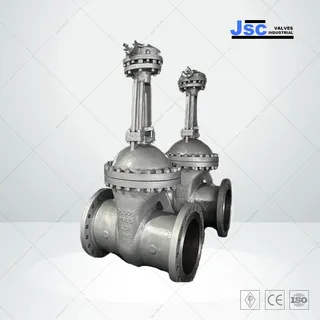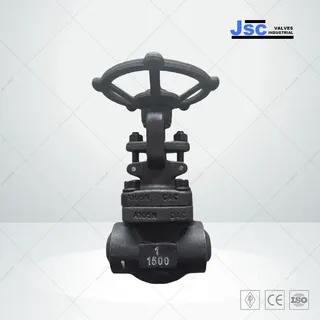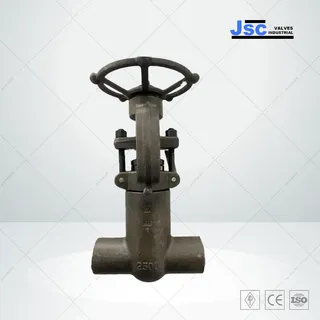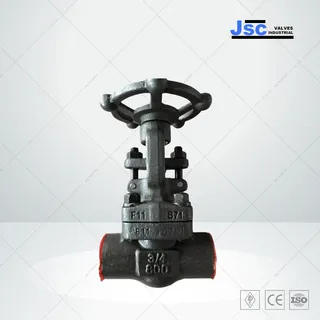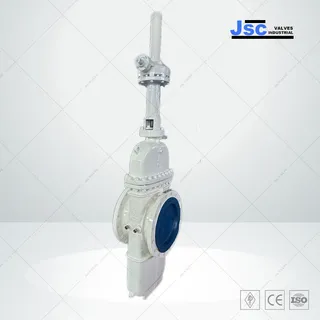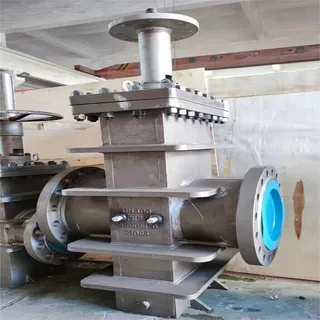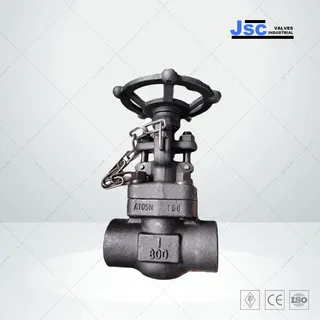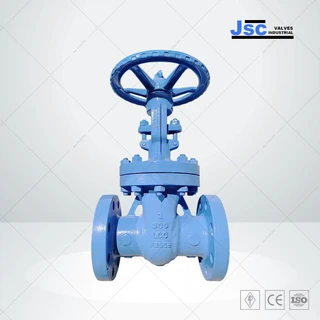Gate Valves
A Gate Valve is a valve that controls fluid flow in a pipeline using a flat, wedge-shaped gate (often made of metal) that moves back and forth to manage the flow. This type of valve is common in many industries because it allows a direct, clear path for fluid and can securely stop the flow when completely closed.
1-12 of 45 results
Explore our top-tier wedge gate valve meticulously crafted in our Chinese factory, featuring premium ASTM A217 WC6 materials and adhering to API 600 standards. With a size of 12 inches (DN300) and a pressure rating of Class 300 LB (PN50), this valve ensures optimal performance in various industrial settings. Its rising stem design, OS&Y configuration, and full bore construction guarantee ease of operation and maintenance. Equipped with a bolted bonnet and RF ends, our gate valve exemplifies reliability and longevity in fluid control applications.
JSC-240919-CSGAV-01
This rising stem gate valve, manufactured to API 600 standards, is made from ASTM A216 WCB material. It features a 14-inch size, Class 300 LB rating, and a raised face (RF) connection. The valve includes a bolted bonnet, outside screw and yoke (OS&Y) design, full bore, and a flexible wedge gate, making it ideal for precise flow control and reliable shutoff in demanding industrial applications.
JSC-240910-FSGAV-01
Our stainless steel gate valve plant specializes in producing high-quality valves crafted from ASTM A351 CF8M stainless steel. These valves adhere to API 600 standards and feature an 18-inch diameter with a Class 600 LB pressure rating. Designed with a bolted bonnet, OS&Y (Outside Screw & Yoke) design, and a rising stem, they offer a full bore for unrestricted flow. The flexible wedge ensures reliable sealing and performance, while the RF (Raised Face) ends facilitate easy installation and maintenance.
JSC-240621-CSGAV-01
This 20-inch Flexible Wedge Gate Valve, manufactured to GOST 5762 standards with ASTM A352 LC1 material, is designed for Class 300 LB pressure applications. It features a bolted bonnet, OS&Y mechanism, rising stem for ease of operation, and full bore design for minimal pressure drop. With flanged ends for easy installation, it ensures reliable performance and durability in demanding industrial settings.
JSC-240607-FSGAV-01
Introducing our API 602 compliant Reduced Bore Gate Valve. Crafted from ASTM A105N Forged Carbon Steel, it's built for durability. With a 1-inch size and Class 1500 LB rating, it's ideal for high-pressure environments. Features include a bolted bonnet, 13cr Metal Seat, and butt-welded ends for secure connections. Perfect for industrial applications requiring reliability under pressure.
JSC-240524-FSGAV-02
Introducing our Pressure Seal Bonnet Gate Valve: meticulously crafted for high-pressure applications. Constructed from forged Carbon Steel ASTM A105N, it ensures durability and reliability. Compliant with API 602 standards, it meets stringent quality requirements. Sized at 1 inch for Class 2500 LB applications, it's ideal for critical environments. Featuring a Pressure Seal Bonnet (PSB), reduced bore, and metal seat, it ensures efficient fluid control. With socket welded ends for secure sealing, our valve offers dependable performance in high-pressure systems.
JSC-240524-FSGAV-01
Discover our ASTM A182 F11 Compact Gate Valve: Precision-crafted for reliability and efficiency in fluid control. This forged steel valve complies with API 602 standards, ensuring robust performance. Sized at 3/4 inch (DN20) for Class 800 LB and PN150 applications, it's ideal for critical environments. Featuring a bolted bonnet, reduced bore design, and NPT thread ends, it offers secure sealing and easy installation. Our valve delivers dependable performance you can trust in various industrial settings.
JSC-240524-CSGAV-01
Introducing our Through Conduit Flat Gate Valve: Engineered to API 6D standards for reliability. Constructed from ASTM A216 WCB for durability, it's sized at 16 inches for Class 150 LB applications. Featuring a full bore design and Double Block & Bleed (DBB) functionality, it ensures efficient fluid isolation. With piggable construction and RTJ ends for secure sealing, our valve offers dependable performance.
JSC-240511-CSGAV-01
We supply the Grove G4N flat gate valve, constructed from carbon steel ASTM A515 Grade 70, suitable for DN300 (12 inch) pipelines with PN63 (Class 400 LB) pressure rating. This valve features a double block and bleed design, ensuring full bore functionality, and is equipped with RTJ ends for secure sealing.
JSC-240511-FSGAV-02
Our factory produces ASTM A105N forged gate valves, equipped with a lock device for added security, meeting API 602 standards. With a size of 1 inch for DN25 and rated for Class 800 LB or PN150, these valves are suitable for high-pressure applications. They feature a bolted bonnet, reduced bore, and RF ends, ensuring reliable performance in various industrial settings.
JSC-240511-FSGAV-01
We manufacture compact forged gate valves meeting API 602 standards, crafted from ASTM A105N. These valves are designed for high-pressure applications, with a size of 3 inches for DN80 and rated for Class 1500 LB or PN250. Featuring a bolted bonnet, metal seat, reduced bore, and butt-welded ends, they ensure reliable performance in demanding environments.
JSC-240409-CSGAV-01
Explore our top-tier wedge gate valve meticulously crafted in our Chinese factory, featuring premium ASTM A352 LCC materials and adhering to API 600 standards. With a size of 3 inches (DN80) and a pressure rating of Class 300 LB (PN50), this valve ensures optimal performance in various industrial settings. Its rising stem design, OS&Y configuration, and full bore construction guarantee ease of operation and maintenance. Equipped with a bolted bonnet and RF ends, our gate valve exemplifies reliability and longevity in fluid control applications.
A gate valve consists of several key components, each playing a crucial role in its operation. Here are the key components of a gate valve:
Body: The outer casing of the valve, holding and supporting internal parts, is built to withstand pressure and fluid flow in the pipeline.
Bonnet: The top part of the valve, securing internal components and creating a seal, is attached to the body. It contains the stem and the valve's operation mechanism.
Gate: A movable obstruction within the valve that manages fluid flow, it can be flat or wedge-shaped. When raised, it allows fluid through; when lowered, it blocks flow.
Seats: Sealing surfaces between the gate and body, ensuring a tight closure when the valve is shut. Seats can be part of the body or replaceable.
Stem: A rod connecting the gate to the actuator. When the actuator moves, it raises or lowers the gate, controlling fluid flow.
Actuator: The mechanism moving the gate, it can be manual (handwheel, lever) or automated (electric, pneumatic, hydraulic). The actuator provides the force for valve operation.
Wedge Configuration: The gate's design, whether solid, flexible, or split, influences the valve's sealing and pressure drop characteristics.
Gate valves are available in various types, each crafted for specific uses and operational needs. Here are some common gate valve types:
Parallel Slide Gate Valve: This type of gate valve uses gates that move parallel to the pipeline axis. This design ensures consistent contact with seats throughout the stroke, reducing wear and ensuring a secure seal.
Wedge Gate Valve: This type of gate valve features a gate with a wedge-shaped profile, offering a mechanical advantage for effective sealing. Wedge gate valves can be categorized into solid, flexible, and split wedge types.
Rising Stem Gate Valve: The valve's stem moves up and down with the gate, providing a visual indication of the valve's position. This type is often used where visibility of the valve status is crucial.
Non-Rising Stem Gate Valve: The valve's stem doesn't move vertically with the gate. Instead, it is threaded into the gate, and turning the stem raises or lowers the gate. This type is suitable for space-constrained applications.
Slab Gate Valve: Commonly used in the oil and gas industry, slab gate valves have a flat gate moving between two parallel seats. They are suitable for applications requiring a tight seal in high-pressure conditions.
Knife Gate Valve: Designed with a sharp-edged gate to cut through and remove debris in the flow path. Knife gate valves are often used in applications with slurries, wastewater, and viscous fluids.
Expanding Gate Valve: The gate in an expanding gate valve is designed to expand across the flow path, creating a tight seal when fully closed. This type is commonly used in pipelines with varying temperatures.
Through-Conduit Gate Valve: This valve has a slab or parallel gate providing a full-bore opening, allowing the passage of tools for maintenance or inspection. It is commonly used in pipeline applications.
Gate valves have several advantages in different industries due to their specific design and operational features. Here are some key benefits of gate valves:
Efficient Fluid Flow: Gate valves, when fully open, provide a straight-through flow path, minimizing pressure drop across the valve. This makes them ideal for applications requiring efficient fluid flow.
Secure Seal: Gate valves can tightly seal when fully closed, preventing fluid flow through the pipeline. This is essential in applications needing complete isolation and leak prevention.
Versatile Sealing: Gate valves are designed for effective sealing in both flow directions, adding versatility to their use in various systems.
Unobstructed Passage: In the fully open position, gate valves offer a full bore, allowing unobstructed passage for fluid. This minimizes flow restrictions and allows tool passage for maintenance.
Low Maintenance: Gate valves have a simple design with fewer moving parts compared to some other valve types. This simplicity results in lower maintenance requirements, making them cost-effective in the long term.
Easy Automation: Gate valves can be effortlessly automated using electric, pneumatic, or hydraulic actuators. This automation enhances control precision and facilitates integration into modern control systems.
Swift Operation: Gate valves can be quickly opened or closed, making them suitable for applications requiring a rapid response.
Reduced Pressure Loss: When fully open, gate valves minimize resistance to fluid flow, leading to decreased pressure loss across the valve. This is beneficial in systems where energy efficiency is a consideration.
Gate valves are widely used in various industries due to their specific design features and functional advantages. Here are typical applications of gate valves:
1. Water and Wastewater Treatment: Gate valves play a crucial role in water treatment plants by controlling the flow of water and various chemicals. They are also essential in wastewater treatment systems.
2. Oil and Gas Industry: Gate valves are pivotal in the oil and gas sector, especially in transporting crude oil, refined products, and natural gas through pipelines.
3. Chemical Processing: Gate valves are employed in chemical plants to regulate the flow of different chemicals. Their effective shut-off capability is vital for preventing leaks and ensuring safety.
4. Marine Applications: Gate valves are commonly utilized in shipboard systems to control fluids, including seawater systems, ballast systems, and fuel systems.
5. Mining Industry: In mining operations, gate valves are utilized to control the flow of slurries, tailings, and other abrasive materials.
6. Fire Protection Systems: Gate valves are integrated into fire protection systems to regulate water flow in sprinkler systems and hydrants.
Gate valves are essential components in fluid handling systems, providing reliable control and isolation of fluids in various industrial applications. The specific type of gate valve chosen depends on the application, fluid characteristics, and operational requirements.

